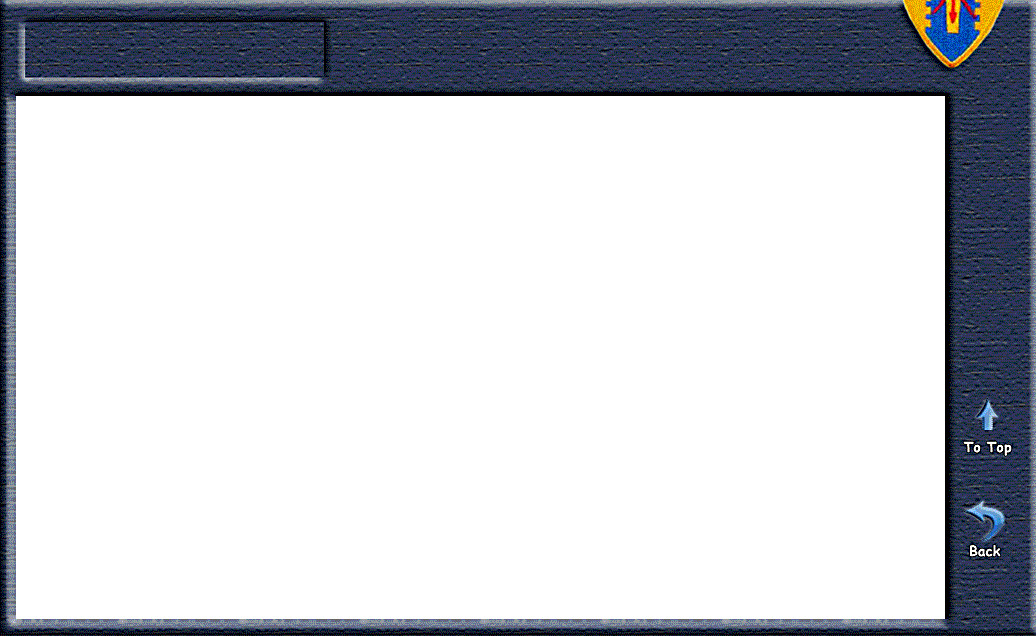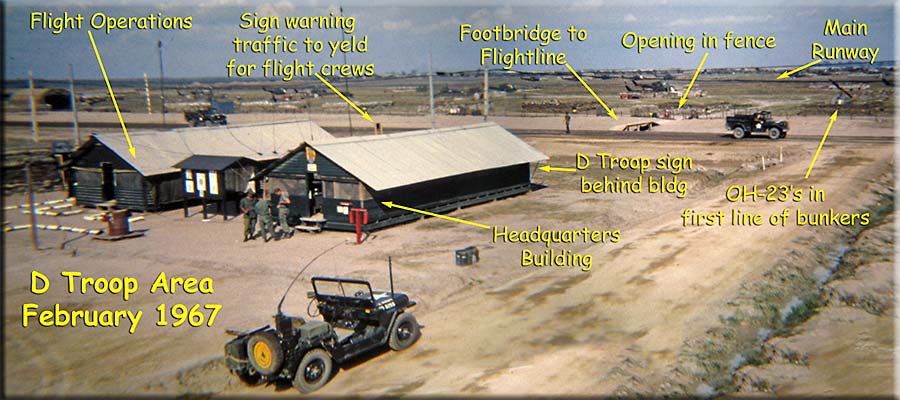

A Troop Commanders detailed summary of D Troop; what it was and how it operated in 1967 (Troop area photo)
.....................................................................................................................................................................................
The 25th ID was stationed at Cu Chi with two brigades (1st & 2nd), the majority of the division base, and supporting aviation, artillery, and logistical support.
The 1st Aviation Bde had an Assault Helicopter Bn (269th AHB) with one AHC (117th Hornets) at Cu Chi
The 3/4 Cav was stationed at Cu Chi with HHTrp, A, B, C, and D troops. The Squadron had three armored troops and one air troop as well as a Long Lange Reconnaissance Company. The LRRP Company was forming in the fall of 1967 after expanding from a LRRP Detachment that had been attached to D troop. In the fall of 1967 the LRRP was employed and trained principally by D Trp.
The armor troops had three identical platoons made up of a HQ track, 4.2 mortar track, two M-48A3 tanks, an infantry track and four scout tracks. All tracks except the mortar tracks were M-113 ACAVs. The troop HQ had a radar section, troop CO,s tank and a maintenance section. The "line troops" were principally engaged in MSR security. D Trp's focus was also oriented in large part toward security of the corridors through which the MSRs ran, however it had innumerable other tasks and missions that were a routine part of it day to day mission.
In the fall of 1967, it was generally thought by all that the Viet Cong were very hard pressed and suppressed within the Division Area of Operations. To engage or capture a North Vietnamese soldier was rare. The VC were far from being wiped and were still capable of Battalion and rarely Regimental size operations. Their ranks were thinned and they were having resupply problems. The MSR (Main Supply Route) from Saigon to Cu Chi was rarely interdicted during the daylight, however A Trp lost a whole platoon 1/4 mile from the main gate at 7pm about a month later in an ambush returning to the base camp.
The MSR from Cu Chi to Tay Ninh was occasionally ambushed during the day, mined most every night, and down right dangerous at night for any movement. The MSR from Tay Ninh to Dau Ting was bad day and night. The MSR was the Division's lifeline. No other unit could keep it open. They tried Mech. Inf. Bns and while they were on the road, it got bad to worse. Even reinforcing them with a tank company did not make much difference.
Occasionally the squadron got an attached Mech. Co and could break a troop away for a search and destroy operation. When D Trp need reinforcement to exploit or to break off decisive engagement with the Aero Rifle Platoon, the squadron often dismounted elements and they would be air lifted in. Preferably, the armor troops would dash cross-country to the rescue. The 25th ID never had a reserve and if they did designate a unit as a back up you could not count on any reasonable reaction time in response. The Squadron Cdr. frequently counseled not to start any fight D Troop couldn't handle, but that if it did he would be there to back the troop up as a last resort.
D Troop Air was organized with an Aero Scout Plat. Aero Rifle Plat., Weapons Section, Service Platoon, Flight Operations Section, and Troop HQ. This was the original TO&E modified with a second WO pilot in each utility helicopter seat not filled, door gunners on all utility helicopters, dismount rifle platoon leader, and a troop XO. No plat Sgt. in the flight platoons or service platoon.
In the service platoon the supply Sgt. was to act as platoon Sgt. The WO maintenance officer was the section leader of the maintenance section of 12 aircraft mechanics, 2 armorers, 2 avionics techs and a Technical Inspector. A very lean TO&E developed to sell the unit to the personnel people at DA when the ROAD Division was devised in 1962 and not modified substantially.
The personnel manning situation was challenging, By the fall of 1967 the pipe line was dry. Every experienced aviator had all ready been once and was not yet ready to return. As troop Co I had been a hold back in Germany where I was Cdr. of D/3/12/Cav until Feb. of 1967. In the fall of 1967 only one other aviator in the troop had flown a helicopter operationally before this assignment Centaur - 30 (Cpt. Wilde). Two other officers had been fixed wing aviators and were transitioned in route (Maj. Fisher and Maj. Vinson). All other officers and warrants were on their first tour of duty, straight from flight school, many still in their teens.
All the equipment in the troop was new in March of 1966 when the troop arrived in country. By the fall of 1967 most of the aircraft had 1000 + hours and were starting to show their age. The troop was equipped with 9 OH-23G observation helicopters with skid mounted M-60 mg placed in the light scout section. This helicopter was prone to cooling fan gearbox failures and only a few had armor plate in the seat. The OH 23G had a FM radio, ARC 44, and a 12 UHF channel transmitter and hand-tuned receiver. (The little scouts left it on 243.0)
The Light Scout Section operated like a platoon but was under the Aero Scout Platoon Leader. Pink teams were impractical with UH-1C high cover. The OH 23G served the troop well but no one was sorry to see it go in 1968.
The Heavy Scout Section had 5 UH-1C gunships mounting two door gunners (one a crew chief) with free mounted M-60 mgs and a weapons system employing two flex mini guns over seven round rocket pods.
The Aero Weapons Section had 4 UH-1C hogs with two 24 round M-2 rocket pods and a 40 mm chunker in the nose along with its two door gunners employing free M-60 mgs. The weapons section most often operated as a cross attachment with the Heavy Scout aircraft, however they could and did operate as a mini ARA. The availability of the "hogs" was lower than the gunships because of the pounding from the 40-mm and the heavy gross weight they operated at. Often they would limit fuel to compensate for ammo.
The Aero Rifle Plat had 5 UH-1D with an infantry squad in 4 and Plat HQ in the remaining one. Each squad was led by an experienced E- 6 and had two good Sgt. Each squad had two m-60 mg, two M-79 grenade launchers, and a PRC - 25 radio (all on the Trp FM frequency). The Platoon Leader was the over all platoon ldr, however the Lt. who led the Aero Rifles on the ground was the undisputed leader of the infantry element. Sounds strange, but it worked.
The Service Platoon had one UH-1D for the maintenance officer and they did most of the logistical support missions as well as dust-off and recovery of aircraft and crews. Troop HQ. Had a UH-1C with two 7 rd. rocket pods for marking, two door gunners, a double stacked VRC-46 console with antennas aligned with the skids and wired into the aircraft communications system. Each UH-1 had a VHF receiver and a five or six channel VHF transmitter. The gunships principally used this for air to air coordination.
The forward observer assigned to the troop was part of the mission crew. He acted as an Arty LNO as well as adjusting fires. The communication traffic within the troop C&C helicopter was a busy, often hectic place with one UHF, one VHF, three FM's, and intercom active at the same time. The Arty FO often carried and used his own PRC-25 for arty coordination. Because of the workload in the C&C the Cdr. often took either the XO or the Flt Opns Officer with him to assist coordination. On this operation, the XO is airborne with the Cdr. and the Flt Opns Officer is on the ground with the 65 element.
D Troop was located on Cu Chi airfield. All aircraft were parked in L shaped, five-ft. high sandbag revetments, 50m apart in three rows along the West Side of the runway.

............Photo of the Troop Headquarters area; camera facing Northeast approximately 060 or 070 degrees. Runway 04/22...........
The Maintenance section had a 50' by 50' neoprene pad to work on, no overhead cover, and a only GP Medium tent for parts and administration. The troop cantonment area was about 150m by 300m immediately adjacent to the perimeter road and across from the aircraft. The structures consisted of: GPM tent kits with tin roofs for billets, mess, supply, flight operations and troop HQ: 5 GP Small tent kits for the Trp Cdr. and other senior leadership; a small club EM; an outdoor movie screen; two showers and latrines, (one for officers and one for enlisted); and a number of above ground bunkers made up the troop area.
The Showers were fed from a well the Aero Rifles dug that had black painted drop tanks (tepid water only at 1700). The Rifles had a double open-ended bunker adjacent to flight operations and the path to the helicopters. In it they had their equipment, weapons and ammunition hung on pegs by squad. When the troop alert siren signal sounded they only had to run in one door in their jungle fatigues and come out the other side dressed, armed and ready to load.
The entire troop was on 15 minute alert for 364 of the 365 days I was there. On the one-day of stand down, we lost a complete gunship crew, called out by division for a special operation.
Call Signs
• Saber - Squadron
• Saber 6 - Cdr.
• Saber Alpha - A Troop
• Saber Delta - D Troop (when on Squadron net )
• Saber ( A,B,C,D) 65 - NCS
• Centaur - D Troop call sign.
• Centaur 6 Troop Cdr. Maj. Fleming
• Centaur 65 Flight Operations (NCS)
• Centaur 3 Flight Operations Officer Maj. Vinson
• Centaur 4 Service Platoon Ldr (Also use call sign Stable Boy on support or medevac missions)
• Centaur 5 XO Maj. Fisher
• Centaur 30 Aero Rifle Plat Cdr. Cpt. Wilde
• Centaur 36 - 39 Lift Aircraft
• Centaur 35 Aero Rifle Plat Ldr Lt. Mosenthal
• C… 31Alpha - 34 Alpha Rifle squads
• Centaur 10 Aero Sct Plt Cdr. Cpt. Stephens
• Centaur 11 - 19 Lt Sct
• Centaur 20 - 29 Hv Sct
• Centaur 40 Aero Weapons Ldr
• Centaur 41 - 44 Weapons hogs
• Falling Yeoman - MACV ARVN District
• Pipe Smoke - 334th Maintenance Bn (downed Acft. recovery element)
• Issue - USAF FAC assigned to 25th ID
• Bolt Eco - E Co 725 Maint Bn. (DS Acft Maint)